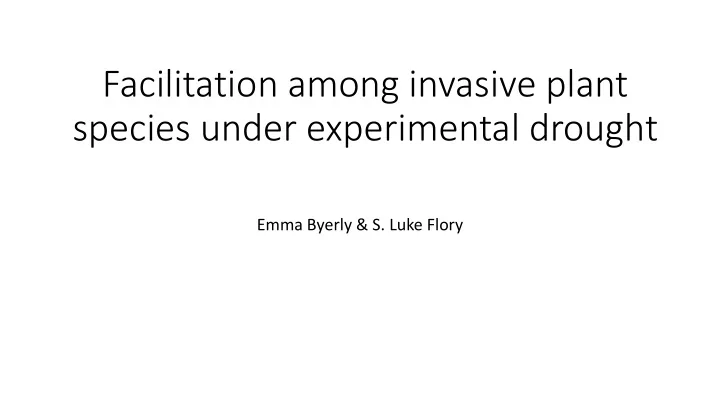

Facilitation among invasive plant species under experimental drought Emma Byerly & S. Luke Flory
Multiple Species Invasions • Most research focused on effects of a single invasive species • Usually 3 or 4 invasive plants co- invade • Shortage of studies on multiple plant invaders Kuebbing et al., 2013)
Facilitation • Novel interactions • Can be beneficial, neutral, or negative • Microstegium facilitated Alliara due to offset phenologies (Flory and Bauer, 2013) • May mitigate effects of harsh environmental conditions (Lortie et al., 2004) • In Southeast US, seasonal droughts will occur more frequently (Mulholland and Best 1997) • Invasional meltdown (Simberloff & Von Holle, 1999) • Primary invasion facilitates secondary ones
Research questions • How do cogongrass invasions influence the establishment success of secondary invaders? • How do drought conditions influence these interactions?
Primary Invader • Cogongrass ( Imperata cylindrica ) • C4 rhizomatous grass • Extensive network of rhizomes (Dozier et al., 1998; Estrada and Flory, 2015) • May mediate effects of drought
Secondary Invaders • Brazilian pepper tree ( Schinus terebinthifolius ) • Fast growth, drought resistant, high seedling survival (Ewel et al., 1982) • Found in association with cogongrass (Platt et al., 2001) • Lantana ( Lantana • Chinese tallow tree camara ) ( Triadica sebifera ) • Tolerates low annual • Prefers more mesic rainfall (Gujral and conditions Vasudevan 1983) • Taproot ( Scheld et al., • Anecdotal accounts of 1981) lantana suppressing cogongrass (Burkill 1935)
Possible Outcomes Drought + Invasion = ↓↓ Drought + Invasion = ↑↓ + +
Methods Native spp. Native spp. Ambient Drought rainfall treatment X 10 replicates Invasion Invasion Ambient Drought rainfall treatment • Secondary invaders planted in plots June 2016 • Survival and performance data collected July – November 2016
Chinese Tallowtree 74% 78% p = 0.0001 p = 0.0002 9x 2x p = 0.04
Lantana 19% 2x p = 0.004 p < 0.0001 4x 1.8x p = 0.0191
Brazilian Peppertree 2x (p = 0.0001) 2x 2x (p = 0.0805)
Summary table Spp. Survival Herbivory Average Biomass Total Biomass Reproduction Chinese tallow ↓78% (invasion) ↑74% (invasion) ↑868% (invasion) ↑111% (invasion) NA Lantana ↓19% (invasion) ↑213% (invasion) ↑400% (drought) NA ↑ 30% (invasion) ↑ 67% (drought) Brazilian pepper Ø ↑215% (invasion) ↑111% (invasion) ↑100% (invasion) NA
VWC water content 2015 • Soil moisture higher in ambient plots • Under drought conditions, invaded plots have greater soil moisture
PAR light data 2015
Take home • There is some evidence that cogongrass facilitates secondary invaders • Facilitation due to drought or invasion is species-specific • Dependent on traits of both primary and secondary invaders • Indirect effects of invasion may mediate interactions among invaders Acknowledgements: Chris Wilson Jules NeSmith Chrissy Alba
Flowering • 33 individuals: • 19 drought, resident vegetation • 9 ambient rainfall, invaded • 7 drought, invaded • Number of inflorescences, reproductive biomass
Rodent damage
Recommend
More recommend